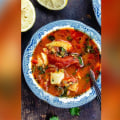Olives and antipasti are two staples of Mediterranean cuisine. They can be found in most grocery stores, from the local market to the specialty store. Olives and antipasti bring a unique flavor to dishes, adding a depth of flavor that can’t be replicated with other ingredients. But what exactly is an olive or an antipasti? What makes them special? How are they used? In this comprehensive overview, we'll explore the history and types of olives and antipasti, their uses in Mediterranean cuisine, and tips for selecting and preparing these delicious grocery staples. Olives and antipasti are two of the most beloved staples of Mediterranean cuisine.
From Kalamata olives to prosciutto, these items offer a wide range of flavors and textures, while also providing a variety of potential health benefits. In this article, you'll learn all about the different types of olives and antipasti available, as well as how to use them in your favorite Mediterranean recipes. Kalamata olives are perhaps the most popular type of olive in the Mediterranean diet. They have a dark purple color, a rich, nutty flavor, and a firm texture. They are often used in salads and can also be enjoyed as an appetizer or snack.
Castelvetrano olives are another popular type of olive. They are bright green in color, have a mild flavor, and are slightly softer than Kalamata olives. Green olives, on the other hand, have a milder flavor than their Kalamata counterparts, and can be enjoyed as an appetizer or snack. When it comes to antipasti, prosciutto is one of the most popular options. It is a cured Italian ham that is sliced thin and served as an appetizer or side dish.
Salami is another popular antipasto item. It is made from cured beef or pork and has a spicy, smoky flavor. Artichokes and capers are two more common antipasti items, which have a slightly bitter flavor and can be enjoyed as part of an antipasto platter. In terms of using olives and antipasti in Mediterranean cooking, they can be used in a variety of ways. Olives are often used to top pizzas or add flavor to pasta dishes.
They can also be chopped up and added to salads or sandwiches for extra flavor and texture. Antipasti items like prosciutto and salami are often used in Italian dishes like lasagna or pasta puttanesca. Artichokes and capers can be used to add flavor to salads or cooked dishes. When it comes to choosing the freshest ingredients for the best flavor, it is important to purchase olives and antipasti from a reputable source. Olives should be firm and plump with no signs of spoilage.
Antipasti items should also be fresh and free of any off-odors or discoloration. Additionally, it is important to use olives and antipasti as soon as possible after purchase for the best flavor. Finally, here are some delicious recipes that make use of olives and antipasti:
- Prosciutto-Wrapped Asparagus – This easy-to-make appetizer features asparagus wrapped in prosciutto for a delicious combination of flavors.
- Artichoke-Tomato Salad – This light and healthy salad combines artichoke hearts, tomatoes, feta cheese, and Kalamata olives for a delicious Mediterranean-style salad.
- Caprese Sandwich – This classic Italian sandwich features fresh mozzarella cheese, tomatoes, basil, olive oil, and capers for a flavorful lunchtime treat.
How to Choose the Freshest Olives & Antipasti
Choosing the freshest olives and antipasti in a Mediterranean grocery store is the key to creating a delicious and memorable meal.Fortunately, there are several techniques that can help you identify the best quality olives and antipasti.
Olives:
When selecting olives, be sure to look for ones that are plump and firm, with no signs of wrinkles or discoloration. The color of the olive should be consistent throughout, and its aroma should be mild and pleasant. If possible, try tasting a few olives before buying them – they should have a slightly bitter flavor, without any notes of rancidity.Prosciutto & Salami:
When choosing prosciutto and salami, look for products with an even color and texture.Avoid products that are overly dry or have visible mold. As with olives, it's best to taste the product if you can – prosciutto should have a mild, salty flavor, while salami should have a subtle smokiness. By following these tips when shopping for olives and antipasti, you can ensure that your Mediterranean grocery store purchases are always of the highest quality.
Uses for Olives & Antipasti
Olives and antipasti are incredibly versatile ingredients, and can be used in a variety of dishes to add flavor and texture.Olives are often served as a snack or appetizer, either as a whole or stuffed with herbs, garlic, or cheese. They can also be chopped and added to salads or pasta dishes for extra flavor. Antipasti are usually served as part of a larger meal. Popular dishes include bruschetta, caprese salad, and antipasto platters.
Olives and antipasti can also be used in cooking. Olives are an excellent addition to stews, soups, and sauces, adding depth and flavor. They can also be combined with other ingredients to create flavorful marinades and dressings. Antipasti can be used in a variety of dishes, from pizzas to pastas.
They can also be added to salads for texture and flavor. When cooking with olives and antipasti, it's important to remember that they can be quite salty. To balance out their flavor, pair them with other ingredients that can cut through the saltiness. Fresh herbs like parsley, oregano, and basil are excellent choices.
For a bit of sweetness, try adding a touch of honey or maple syrup. For a bit of heat, add some chili flakes or a pinch of cayenne pepper. Overall, olives and antipasti are incredibly versatile ingredients that can be used in a variety of dishes. From snacks and appetizers to main courses and side dishes, these two items are essential to any Mediterranean grocery store.
With the right combination of ingredients, you can create delicious and flavorful dishes that will delight your taste buds.
Types of Antipasti
Antipasti is a type of appetizer or starter that is a staple of the Mediterranean diet. It typically consists of cured meats, vegetables, cheeses, and other savory items. There are many types of antipasti, each one providing a unique flavor and texture to the meal. Some of the most popular types of antipasti include prosciutto, salami, artichokes, capers, and olives.Prosciutto is an Italian dry-cured ham that has been aged for at least 12 months. It is characterized by its rich, salty flavor and silky texture. It can be served as slices on its own, or used as an ingredient in salads and other dishes. Prosciutto is high in protein and low in fat, making it a healthy addition to any meal.
Salami is a type of Italian cured sausage that is made from pork or beef. It is usually served as thin slices and has a savory, smoky flavor. Salami is high in protein and low in fat, and can be used as an ingredient in dishes or enjoyed as a snack.
Artichokes
are a popular type of vegetable that have a mild, nutty flavor.They are usually boiled or steamed and served with dips or sauces. Artichokes are high in fiber, vitamins, and minerals, making them a nutritious choice for any meal.
Capers
are small flower buds that have been pickled in vinegar or brine. They have a sharp, tangy flavor and can be used as an ingredient in salads or sauces.Capers are high in antioxidants and may help to lower cholesterol levels.
Olives
are a type of fruit that come from the olive tree. They have a salty, briny flavor and can be eaten on their own or used as an ingredient in salads and other dishes. Olives are high in healthy fats and can help to reduce inflammation in the body.All of these types of antipasti are delicious additions to any Mediterranean grocery store. They can be enjoyed on their own or used as ingredients to create flavorful dishes. Each type provides unique flavors and textures that will elevate any meal.
Types of Olives
Olives are a beloved staple in the Mediterranean diet, and there are many different types of olives that can be found in a Mediterranean grocery store. Kalamata olives, Castelvetrano olives, green olives, and more – each type has its own unique flavor and texture, as well as potential health benefits.Let’s take a look at some of the popular types of olives found in a Mediterranean grocery store.
Kalamata Olives
Kalamata olives are one of the most popular types of olives found in a Mediterranean grocery store. These olives are dark purple-brown in color and have a smooth skin. They have a slightly salty taste and firm texture. Kalamata olives are often used in salads, pizzas, and as a topping for other dishes.Additionally, they are high in healthy fats and provide antioxidants.
Castelvetrano Olives
Castelvetrano olives are another popular type of olive found in a Mediterranean grocery store. They are medium-sized green olives with a mild flavor and creamy texture. Castelvetrano olives can be used in salads, pastas, and pizzas, as well as served as an appetizer. Additionally, they are high in vitamin E and monounsaturated fatty acids.Green Olives
Green olives are another variety of olive found in a Mediterranean grocery store.These olives are usually smaller than Kalamata or Castelvetrano olives and have a bright green color. Green olives have a tart flavor and firm texture. They are often used to make tapenades or served as an appetizer. Additionally, they are high in healthy fats and provide antioxidants.
Cerignola Olives
Cerignola olives are large, bright green olives with a mild flavor and buttery texture.Additionally, Cerignola olives are high in healthy fats and provide antioxidants.
Picholine Olives
Picholine olives are another type of olive found in a Mediterranean grocery store. These olives are small and bright green in color with a mild flavor and firm texture. Additionally, Picholine olives are high in healthy fats and provide antioxidants. Olives and antipasti are essential ingredients of the Mediterranean diet, bringing flavor, texture, and nutrition to any meal. In this article, we’ve explored the different types of olives and antipasti, their uses, and how to choose the freshest ingredients.We’ve also included some delicious recipes to help you get started with cooking with these two staples. With their incredible versatility, olives and antipasti make an excellent addition to any kitchen.


